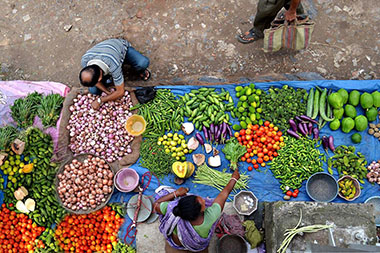The following blog story by Bioversity’s Gina Kennedy and HravestPlus’ Mourad Moursi was originally published on the HarvestPlus website.
Some 2 billion people suffer from hidden hunger caused by infections and diets lacking in essential micronutrients such as vitamin A, iron, and zinc. This is particularly the case in the developing world, where diets mainly consist of starchy staples and not enough nutrient-rich foods such as fruits, vegetables, beans and pulses, and animal source foods.
But what if those food staples that people eat regularly were made to work toward better nutrition? And how does that fit with the need for dietary diversification?
UNDERSTANDING HOW BIOFORTIFICATION IS PART OF DIETARY DIVERSITY
Dietary diversity is a strong predictor of micronutrient adequacy and overall diet quality. Increasing availability and access to a nutritionally diverse range of foods within and across different food groups is key to ensure adequate intake of essential nutrients required for healthy, productive lives.
Understanding the seasonality of nutrient-rich food supplies—when and how long they are available during the year—plays an equally important role toward adequate intakes.
However, getting people to eat more nutrient-rich foods and fewer staples is very challenging, especially in resource-poor settings where access, availability, and affordability are constrained. Purchasing decisions related to food are driven by income, culture, and personal preference, and have also been shown to be price sensitive. In Ouagadougou, Burkina Faso, for example, food staple consumption remained completely unchanged between 2007 and 2008 in spite of a 53 percent increase in price. People maintained their consumption of staples but consumed fewer nutrient-rich fruits and vegetables (-31 percent), dairy products (-21 percent), and meat and poultry (-18 percent). Data from the Philippines clearly shows that food staple consumption remains constant across quintiles of income. As income goes up, dietary diversity improves as more diverse and expensive foods are added.
However, incomes of the poorest would have to increase by ten-fold or more to achieve adequate mineral and vitamin intake levels. Entire generations would continue to suffer from micronutrient deficiencies before that magnitude of increase in income could be achieved. In some cases, increased spending on food does not translate into nutritional gains at all as the consumption of empty calories—calories which provide no additional micronutrients, such as those coming from soft drinks, sugar and some processed foods—also typically increases with higher incomes. This highlights the essential role of nutrition education and promoting the health benefits of nutritionally sound food choices.
Because food staples are consumed regularly in large quantities, biofortification is an efficient and cost-effective way of bringing more micronutrients to the diets of the poor. It contributes to improving the diet quality of populations, and can be viewed as integral to dietary diversity. Biofortification is not promoted to increase consumption of staples. Rather, it is used to substitute some or all of the non-biofortified equivalent staples from the diet with better and more micronutrient-rich varieties. Such a strategy recognizes that there are limits on how much energy should be derived from carbohydrates, and does not encourage people to solely rely upon, or increase, the consumption of biofortified staples as they cannot provide the full array of nutrients. In some instances, as successive waves of biofortified crops with increased levels of vitamin A, iron or zinc become available in countries, people will be able to get the same amounts of the micronutrient of interest with decreasing consumption of biofortified staples.
LOOKING FORWARD
The long term goal is for diets to become more nutritionally diversified as combinations of foods have interactions and benefits beyond supplying single micronutrients. Reviving the importance of locally available nutrient-dense foods such as fruits, vegetables, and beans and pulses within food systems and ensuring greater market access are key strategies to achieve a more diversified diet. This can be accomplished through supportive policies at national level and locally developed solutions, including integrated homestead food production and greater integration of locally available nutrient-dense foods into market systems that can reach urban consumers. Diversification strategies that include nutrition education components, understand the local context, and work directly with women farmers have been some of the more successful approaches.
Biofortified crops present a huge opportunity to provide basic missing nutrients, but also to educate consumers about the benefits of a diverse diet and to promote other locally available nutritious crops. Such efforts are already being deployed at scale in countries such as Uganda, where the promotion of vitamin A orange sweet potato (OSP) and iron beans is accompanied with nutrition education on other good sources of these micronutrients in the local diet. When caregivers are educated on the benefits of nutrients, they are willing to incorporate food sources for those nutrients into their diets. For example, in the case of vitamin A, that means swapping white sweet potato for OSP, but also eating vitamin A-rich foods such as mangoes when they are in season or leafy green vegetables and certain animal source foods when available through local production or purchase. This example illustrates how biofortified foods can be an important component of a holistic approach to dietary diversity: a food-based solution using sustainable locally produced foods to help individuals come closer to meeting their nutritional requirements.
Researchers have started to analyze how biofortification can contribute to dietary diversification through a food basket approach where a variety of biofortified foods can be combined with other locally available foods to maximize their respective benefits. This evidence can help shape policies and programs in order to combine biofortification and dietary diversification into a more unified strategy. Biofortified crops will also be introduced into dietary diversification interventions to figure out which approaches and context-specific set of activities yield the best results in the field. Biofortification should not be seen as a rival or even a complement to dietary diversification, but as an integral component of food-based solutions to improve nutrition and public health by providing people with an array of healthier food choices.







